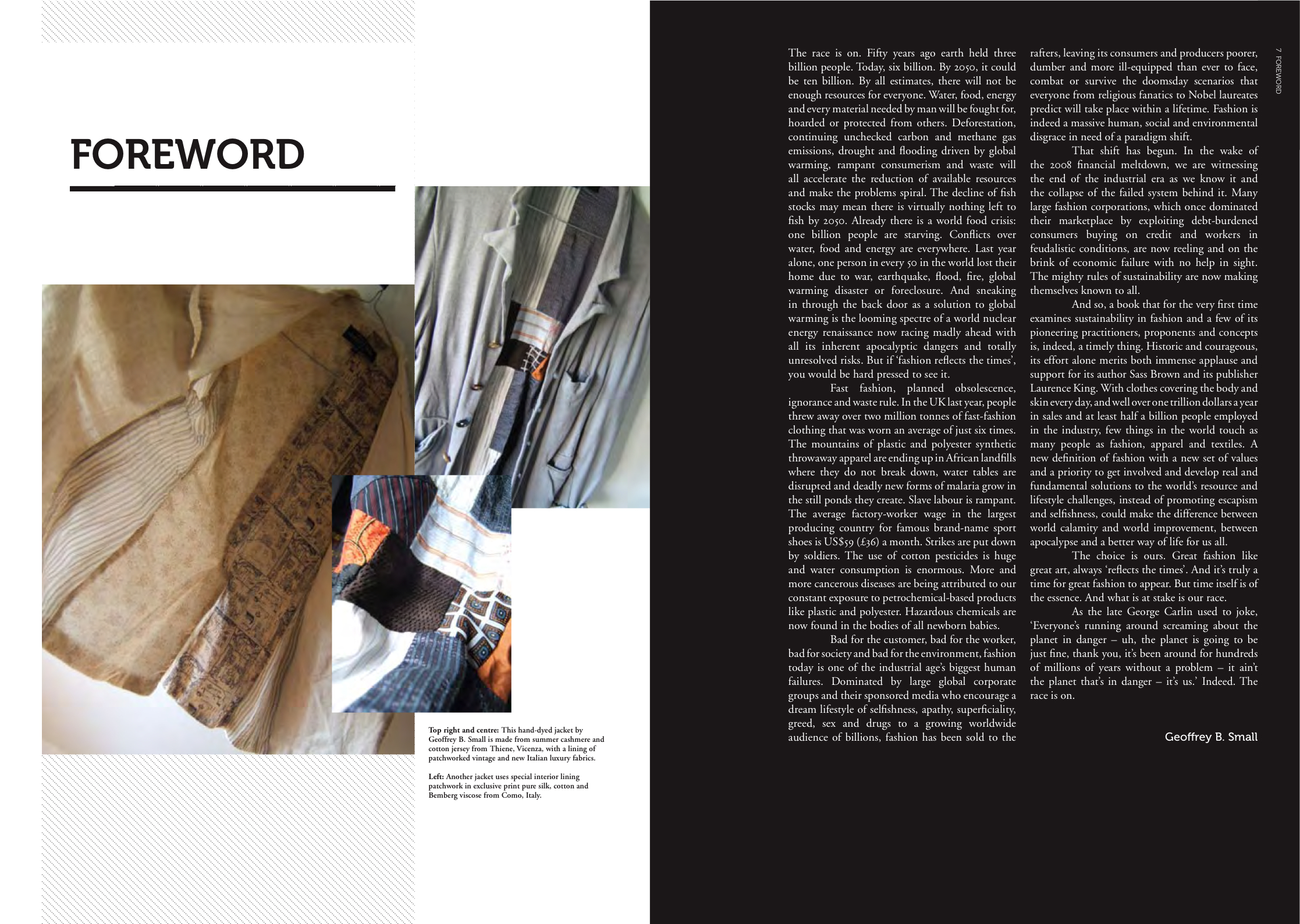The foreword for Eco-Fashion "The race is on." was written by Geoffrey B. Small at the request of
the author and publishers. The book is the industry's
first on
sustainable fashion design and is
written by Sass
Brown, director,
FIT
Fashion Institute of Technology
Florence Italy Program,
and published
by Laurence
King
Publishers Ltd.
London.

London.


GEOFFREY B. SMALL'S TEXT FROM THE FOREWORD PAGE OF ECO-FASHION
"The race is on."
FIFTY years ago earth held three billion people. Today, six billion. By 2050, it could be ten billion. By all estimates, there will not be enough resources for everyone. Water, food, energy and every material needed by man will be fought for, hoarded or protected from others. Deforestation, continuing unchecked carbon and methane gas emissions, drought and flooding driven by global warming, rampant consumerism and waste will all accelerate the reduction of available resources and make the problems spiral. The decline of fish stocks may mean there is virtually nothing left to fish by 2050. Already there is a world food crisis: one billion people are starving. Conflicts over water, food or energy are everywhere. Last year alone, one person in every 50 in the world lost their home due to war, earthquake, flood, fire, global warming disaster or foreclosure. And sneaking in through the backdoor as a "solution to global warming,” is the looming spectre of a world " nuclear energy renaissance" now madly racing ahead with all its inherent apocalyptic dangers and totally unresolved risks.
But if ‘fashion reflects the times’, you would be hard pressed to see it.
Fast fashion, planned obsolescence, ignorance and waste rule. In the UK last year, people threw away over two million tonnes of fast-fashion clothing that was worn an average of just six times. The mountains of plastic and polyester synthetic throwaway apparel are ending up in African landfills where they do not break down, water tables are disrupted and deadly new forms of malaria grow in the still ponds they create. Slave labour is rampant. The average factory-worker wage in the largest producing country for famous brand-name sport shoes is US $59 (£36) a month. Strikes are put down by soldiers. The use of cotton pesticides is huge, and water consumption is enormous. More and more cancerous diseases are being attributed to our constant exposure to petrochemical-based products like plastic and polyester. Hazardous chemicals are now found in the bodies of all newborn babies.
Bad for the customer, bad for the worker, bad for society and bad for the environment, fashion today is one of the industrial age’s biggest human failures. Dominated by large global corporate groups and their sponsored media who encourage a dream lifestyle of selfishness, apathy, superficiality, greed, sex and drugs to a growing worldwide audience of billions, fashion has been sold to the rafters, leaving its consumers and producers poorer, dumber and more ill-equipped than ever to face, combat or survive the doomsday scenarios that everyone from religious fanatics to Nobel laureates predict will take place within a lifetime. Fashion is indeed a massive human, social and environmental disgrace in need of a paradigm shift.
That shift has begun. In the wake of the 2008 financial meltdown, we are witnessing the end of the industrial era as we know it and the collapse of the failed system behind it. Many large fashion corporations, which once dominated their marketplace by exploiting debt-burdened consumers buying on credit and workers in feudalistic conditions, are now reeling and on the brink of economic failure with no help in sight. The mighty rules of sustainability are now making themselves known to all.
And so, a book that for the very first time examines sustainability in fashion and a few of its pioneering practitioners, proponents and concepts is, indeed, a timely thing. Historic and courageous, its effort alone merits both immense applause and support for its author Sass Brown and its publisher Laurence King. With clothes covering the body and skin every day, and well over one trillion dollars a year in sales and at least half a billion people employed in the industry, few things in the world touch as many people as fashion, apparel and textiles. A new definition of fashion with a new set of values and a priority to get involved and develop real and fundamental solutions to the world’s resource and lifestyle challenges, instead of promoting escapism and selfishness, could make the difference between world calamity and world improvement, between apocalypse and a better way of life for us all.
The choice is ours. Great fashion like great art, always ‘reflects the times’. And it’s truly a time for great fashion to appear. But time itself is of the essence.
And what is at stake is our race.
As the late George Carlin used to joke, ‘Everyone’s running around screaming about the planet in danger – uh, the planet is going to be just fine, thank you, it’s been around for hundreds of millions of years without a problem – it ain’t the planet that’s in danger – it’s us.’
Indeed. The race is on.
Geoffrey B. Small
Eco Fashion is available at Amazon.com, Amazon.co.uk, Barnes & Noble, Borders, Waterstones, Blackwell, Tesco Books
and through design bookstores worldwide. For more information contact Laurence King Publishers Ltd., London